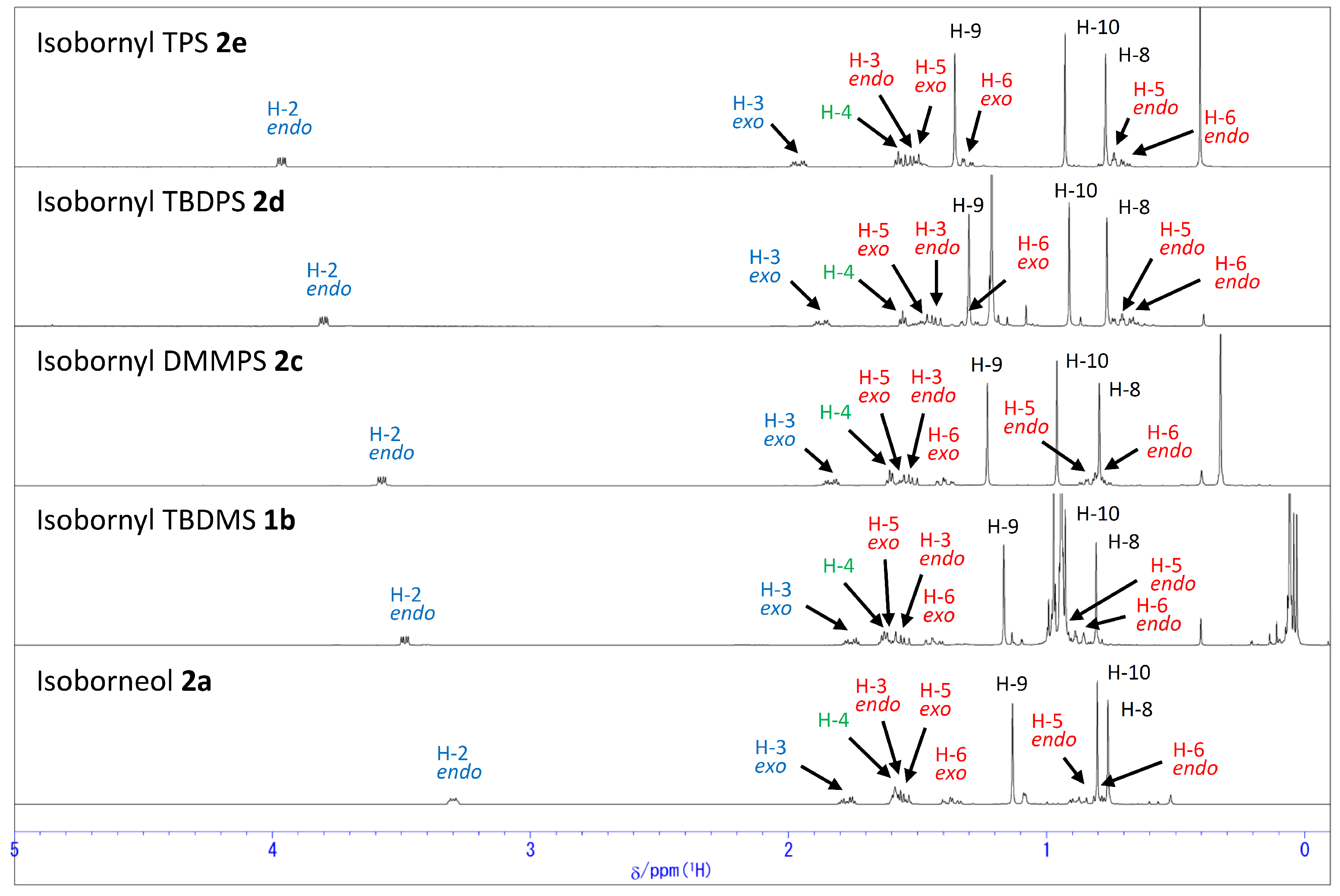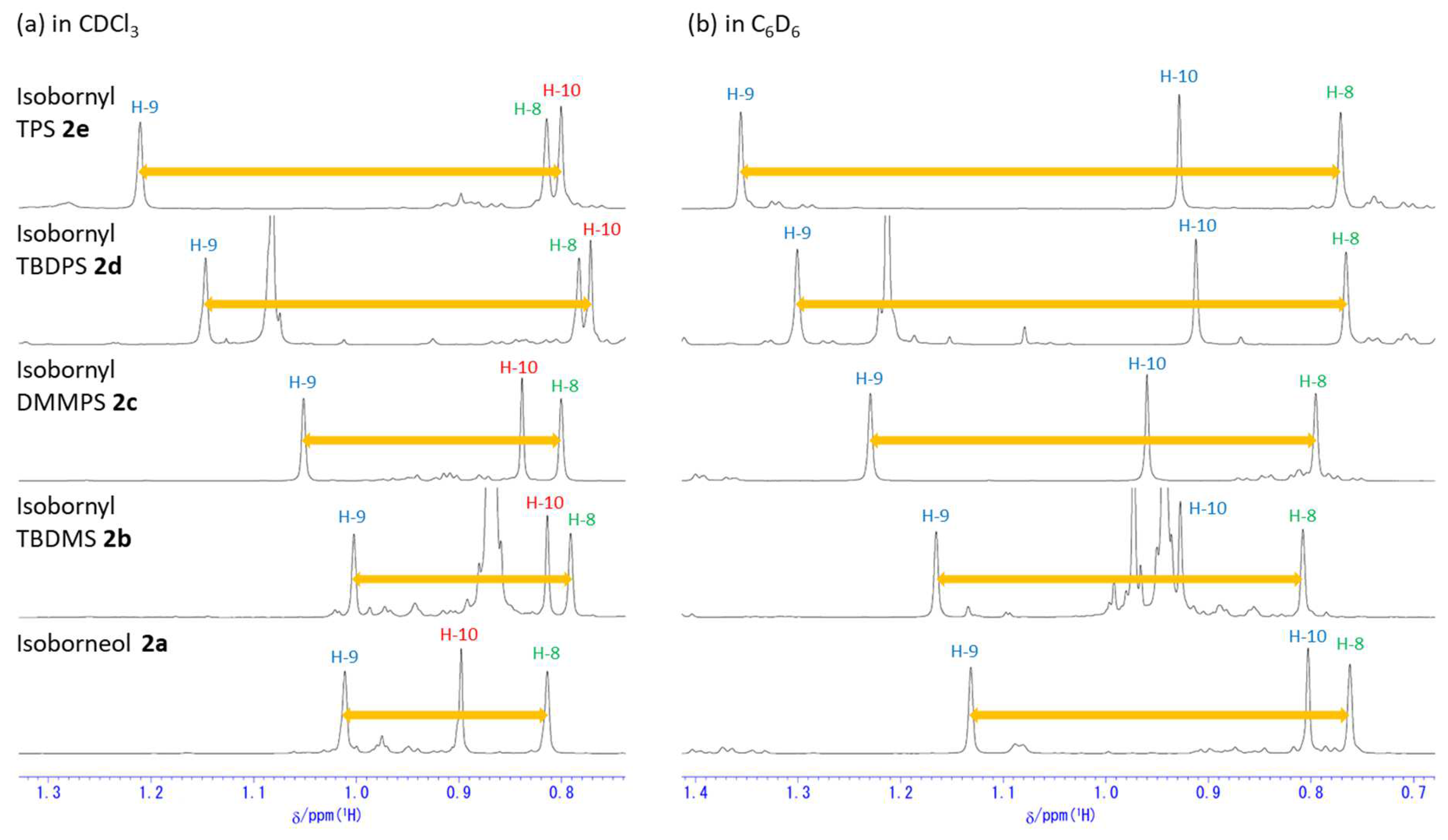The Shielding Effect of Phenyl Groups in the Silyl-Protecting Groups Introduced into Borneol and Isoborneol
Abstract
:1. Introduction
2. Results and Discussion
2.1. 1H NMR Chemical Shift Changes of Borneol in CDCl3 and C6D6 Solutions
2.2. 1H NMR Chemical Shift Changes of Isoborneol in CDCl3 and C6D6 Solutions
3. Materials and Methods
3.1. Chemicals
3.2. NMR Measurements
3.3. General Procedures for Protection of Borneol and Isoborneol with a Silyl-Protecting Group
4. Conclusions
Supplementary Materials
Author Contributions
Funding
Data Availability Statement
Acknowledgments
Conflicts of Interest
References
- Greene, T.W.; Wuts, P.G.M. Protective Groups in Organic Synthesis, 5th ed.; John Wiley & Sons Inc.: New York, NY, USA, 2014. [Google Scholar]
- Corey, E.J.; Venkateswarlu, A. Protection of hydroxyl groups as tert-butyldimethylsilyl derivatives. J. Am. Chem. Soc. 1972, 94, 6190–6191. [Google Scholar] [CrossRef]
- Davies, J.S.; Higginbotham, C.L.; Tremeer, E.J.; Brown, C.; Treadgold, R.C. Protection of Hydroxy Groups by Silylation: Use in Peptide Synthesis and as Lipophilicity Modifiers for Peptides. J. Chem. Soc. Perkin Trans. 1 1992, 22, 3043–3048. [Google Scholar] [CrossRef]
- Marshall, J.A.; Yanik, M.M.; Adams, N.D.; Ellis, K.C.; Chobanian, H.R. Generation of Nonracemic 2-(t-Butyldimethylsilyloxy)-3-butynyllithium from (S)-Ethyl Lactate: (S)-4-(t-Butyldimethylsilyloxy)-2-pentyn-1-ol. Org. Synth. 2005, 81, 157. [Google Scholar]
- Wetter, H.; Oertle, K. Thexyldimethylsilyl Chloride, an Easily Accessible Reagent for the protection of Acohols. Tetrahedron Lett. 1985, 26, 5515–5518. [Google Scholar] [CrossRef]
- Isidro-Llobet, A.; Álvarez, M.; Albericio, F. Amino Acid-Protecting Groups. Chem. Rev. 2009, 109, 2455–2504. [Google Scholar] [CrossRef]
- Liang, H.; Hu, L.; Corey, E.J. Di-tert-butylisobutylsilyl, Another Useful Protecting Group. Org. Lett. 2011, 13, 4120–4123. [Google Scholar] [CrossRef]
- Lyu, B.; Sako, H.; Sugiura, M.; Hiraga, Y.; Takagi, R.; Niwayama, S. 1H NMR Chemical Shift Changes as a Result of Introduction of Carbonyl-Containing Protecting Groups Observed in Bornol and Isoborneol. Molbank 2024, 2024, M1899. [Google Scholar] [CrossRef]
- Bhatia, S.P.; Letizia, C.S.; Api, A.M. Fragrance Material Review on Borneol. Food Chem. Toxicol. 2008, 46, S77–S80. [Google Scholar] [CrossRef]
- Li, Y.; Ren, M.; Wang, J.; Ma, R.; Chen, H.; Xie, Q.; Li, H.; Li, J.; Wang, J. Progress in Borneol Intervention for Ischemic Stroke: A Systematic Review. Front. Pharmacol. 2021, 12, 606682. [Google Scholar] [CrossRef]
- Kulkarni, M.; Sawant, N.; Kolapkar, A.; Huprikar, A.; Desai, N. Borneol: A Promising Monoterpenoid in Enhancing Drug Delivery Across Various Physiological Barriers. AAPS PharmSciTech 2021, 22, 145. [Google Scholar] [CrossRef]
- Rajput, A.; Kasar, A.; Thorat, S.; Kulkarni, M. Borneol: A Plant-Sourced Terpene with a Variety of Promising Pharmacological Effects. Nat. Prod. J. 2023, 13, 13–28. [Google Scholar]
- Baldovini, N.; Tomi, F.; Casanova, J. Enantiomeric Differentiation of Bornyl Acetate by 13C-NMR Using a Chiral Lanthanide Shift Reagent. Phytochem. Anal. 2003, 14, 241–244. [Google Scholar] [CrossRef] [PubMed]
- Gansow, O.A.; Willcott, M.R.; Lenkinski, R.E. Carbon Magnetic Resonance. Signal Assignment by Alternately Pulsed Nuclear Magnetic Resonance and Lanthanide-induced Chemical Shifts. J. Am. Chem. Soc. 1971, 93, 4295–4297. [Google Scholar] [CrossRef]
- Hawkes, G.E.; Leibfritz, D.; Roberts, D.W.; Roberts, J.D. Nuclear Magnetic Resonance Shift Reagents. Question of the Orientation of the Magnetic Axis in Lanthanide-substrate Complexes. J. Am. Chem. Soc. 1973, 95, 1659–1661. [Google Scholar] [CrossRef]
- Levy, G.C.; Komoroski, R.A. Paramagnetic Relaxation Ragents. Alternatives or Complements to Lanthanide Shift Reagents in Nuclear Magnetic Resonance Spectral Analysis. J. Am. Chem. Soc. 1974, 96, 678–681. [Google Scholar] [CrossRef]
- Simova, S. Application of to the Measurement of Homonuclear HSQC Coupling Constants, J(H,H). Magn. Reson. Chem. 1998, 36, 505–510. [Google Scholar] [CrossRef]
- Khandelwal, D.; Hooda, S.; Brar, A.S.; Shankar, R. Stereochemical Assignments of the Nuclear Magnetic Resonance Spectra of Isobornyl Acrylate/Methacrylonitrile Copolymers. J. Appl. Polym. Sci. 2012, 126, 916–928. [Google Scholar] [CrossRef]
- Chavelas-Hernández, L.; Valdéz-Camacho, J.R.; Hernández-Vázquez, L.G.; Dominguez-Mendoza, B.E.; Vasquez-Ríos, M.G. A New Approach Using Aromatic-Solvent-Induced Shifts in NMR Spectroscopy to Analyze β-Lactams with Various Substitution. Synlett 2020, 31, 158–164. [Google Scholar] [CrossRef]
- Kleinpeter, E.; Szatmári, I.; Lázár, L.; Koch, A.; Heydenreich, M.; Fülöp, F. Visualization and Quantification of Anisotropic Effects on the 1H NMR Spectra of 1,3-oxazino[4,3-a]isoquinolines—Indirect Estimates of Steric Compression. Tetrahedron 2009, 65, 8021–8027. [Google Scholar] [CrossRef]
- Harriswangler, C.; Lucio-Martínez, F.; Godec, L.; Soro, L.K.; Fernández-Fariña, S.; Valencia, L.; Rodríguez-Rodríguez, A.; Esteban-Gómez, D.; Charbonnière, L.J.; Platas-Iglesias, C. Effect of Magnetic Anisotropy on the 1H NMR Paramagnetic Shifts and Relaxation Rates of Small Dysprosium (III) Complexes. Inorg. Chem. 2023, 62, 14326–14338. [Google Scholar] [CrossRef]
- Nazarski, R.B. On the Use of Deuterated Organic Solvents without TMS to Report 1H/13C NMR Spectral Data of Organic Compounds: Current State of the Method, Its Pitfalls and Benefits, and Related Issues. Molecules 2023, 28, 4369. [Google Scholar] [CrossRef] [PubMed]
- Bartoszewicz, A.; Kalek, M.; Stawinski, J. Iodine-promoted Silylation of Alcohols with Silyl Chlorides. Synthetic and Mechanistic Studies. Tetrahedron 2008, 64, 8843–8850. [Google Scholar] [CrossRef]
- Wang, L.; Zhang, T.; Redden, B.K.; Sheppard, C.I.; Clark, R.W.; Smith, M.D.; Wiskur, S.L. Understanding Internal Chirality Induction of Triarylsilyl Ethers Formed from Enantiopure Alcohols. J. Org. Chem. 2016, 81, 8187–8193. [Google Scholar] [CrossRef] [PubMed]







Disclaimer/Publisher’s Note: The statements, opinions and data contained in all publications are solely those of the individual author(s) and contributor(s) and not of MDPI and/or the editor(s). MDPI and/or the editor(s) disclaim responsibility for any injury to people or property resulting from any ideas, methods, instructions or products referred to in the content. |
© 2024 by the authors. Licensee MDPI, Basel, Switzerland. This article is an open access article distributed under the terms and conditions of the Creative Commons Attribution (CC BY) license (https://creativecommons.org/licenses/by/4.0/).
Share and Cite
Lyu, B.; Sugiura, M.; Tayama, K.; Hiraga, Y.; Takagi, R.; Niwayama, S. The Shielding Effect of Phenyl Groups in the Silyl-Protecting Groups Introduced into Borneol and Isoborneol. Molbank 2024, 2024, M1908. https://doi.org/10.3390/M1908
Lyu B, Sugiura M, Tayama K, Hiraga Y, Takagi R, Niwayama S. The Shielding Effect of Phenyl Groups in the Silyl-Protecting Groups Introduced into Borneol and Isoborneol. Molbank. 2024; 2024(4):M1908. https://doi.org/10.3390/M1908
Chicago/Turabian StyleLyu, Baohe, Mio Sugiura, Koya Tayama, Yoshikazu Hiraga, Ryukichi Takagi, and Satomi Niwayama. 2024. "The Shielding Effect of Phenyl Groups in the Silyl-Protecting Groups Introduced into Borneol and Isoborneol" Molbank 2024, no. 4: M1908. https://doi.org/10.3390/M1908
APA StyleLyu, B., Sugiura, M., Tayama, K., Hiraga, Y., Takagi, R., & Niwayama, S. (2024). The Shielding Effect of Phenyl Groups in the Silyl-Protecting Groups Introduced into Borneol and Isoborneol. Molbank, 2024(4), M1908. https://doi.org/10.3390/M1908






